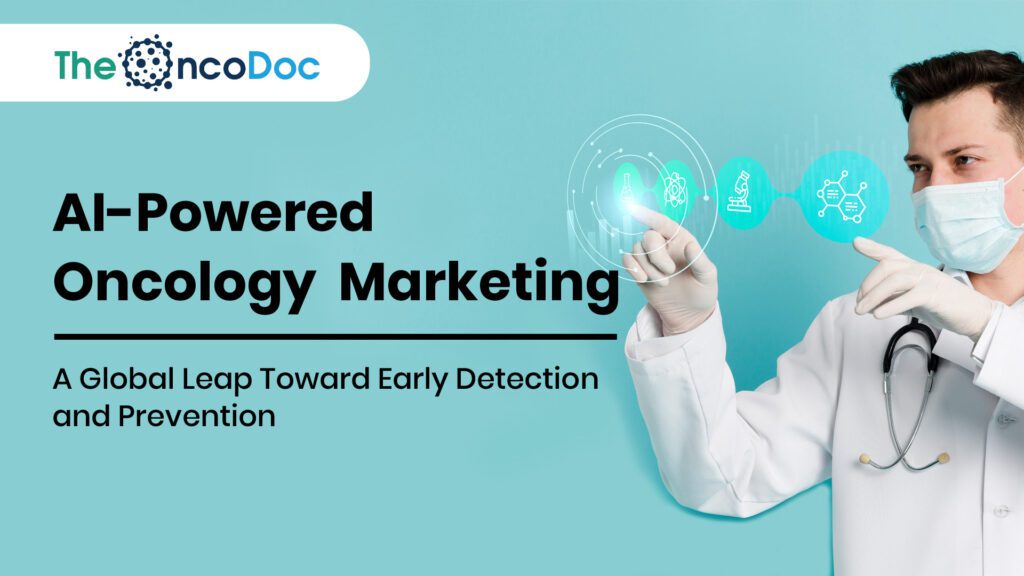Introduction: The Global Shift Toward Preemptive Oncology Care
Around the world, cancer is not only a healthcare burden it is a system challenge. The difference between life and loss often hinges on how soon intervention begins. In today’s connected world, pharma marketers hold the power to shape not just demand, but awareness, access, and action, especially with the strategic integration of AI.
This article explores how pharma companies across continents are leveraging AI, behavioural insights, and multilingual strategies to drive earlier oncology outcomes—before patients ever meet an oncologist.
1. Global Barriers to Early Cancer Detection
From New York to Nairobi, the challenge is universal: patients are arriving too late. But the reasons vary by region.
📝 Insight: The intersection of culture, infrastructure, and awareness is where pharma marketing must intervene early, with locally resonant AI-powered messaging.
2. Smart Content, Smarter Markets: Using AI for Predictive Awareness
AI helps brands move beyond demographics to psychographics, targeting users based on behavior and risk profiles:
- Geo-fenced symptom alerts in high-incidence areas
- Seasonal screening nudges (e.g., lung health in winter)
- AI-generated symptom checkers in local languages
- Behavioural nudges based on search history and wearable data
🧠 Use Case: In Brazil, an AI tool flagged a rise in searches for “persistent cough” and targeted those users with TB and lung cancer awareness videos, resulting in a 19% increase in early screening appointments.
3. Empowering Physicians Worldwide with Digital Microlearning
Oncology doesn’t start in oncology clinics; it starts with frontline providers. AI is helping educate HCPs globally with localised, bite-sized, and context-aware content.
💡 Tactic: Leading pharma firms now push micro-CME content via WhatsApp and mobile apps in rural clinics in Africa and South Asia—bridging the training divide.
4. Localised Storytelling Powered by Global AI Engines
Emotion transcends geography. AI tools segment users not just by disease risk but also by emotional readiness and cultural nuance. Campaigns that feature survivors speaking in their native languages outperform generic global messages by 2.5x.
📌 Example: In Southeast Asia, a survivor-led campaign on cervical cancer awareness in Tagalog increased engagement by 48% compared to English-based counterparts.
5. Regional Campaign Performance: Measuring Relevance
AI allows marketers to move beyond impressions and clicks to emotional resonance and clinical action.
🎯 Insight: North America and Europe show higher CTRs for symptom-checker videos, while Asia-Pacific engages more with chatbot-led nudges. Regional insight drives ROI.
6. Closing the Referral Gap Through Predictive Funnels
AI tracks engagement pathways and drop-off points—then automatically adjusts content sequencing to pull users toward referral or screening.
🧭 Metrics to Watch:
- % of users completing symptom assessments
- Drop-offs between ad interaction and appointment booking
- Click-to-referral conversion time
🔁 Outcome: Pharma marketing becomes a clinical accelerant, not just an educational force.
7. Beyond Borders: Co-Creating with Global NGOs and Ministries
In Africa, AI maps cervical cancer “awareness deserts.” In Latin America, pharma brands co-create WhatsApp campaigns with ministries of health. The future lies in co-branded, AI-informed education, not siloed efforts.
📌 Global Strategy: Use AI to identify “high-risk + low-reach” regions → partner with NGOs → deploy multilingual mobile campaigns.
8. Voice-First Campaigns for the Global South
With literacy barriers across regions like Sub-Saharan Africa and South Asia, pharma is embracing voice:
- Symptom-triage voicebots via IVR
- WhatsApp voice messages with survivor stories
- Smart speaker installations in clinics
🔊 Forecast: Over 600M people in the global south will use voice-first platforms for health information by 2026.
9. The Pharma Marketer’s AI Toolkit for 2025
To win globally in oncology, the future-ready marketer will need to:
✅ Deploy multilingual AI bots for rural screening
✅ Segment campaigns by emotional stage & behavior
✅ Use real-time EMR alerts to influence physician action
✅ Personalise follow-ups post-screening for continuity
📈 KPI Shift: From “impressions served” to “lives redirected.”
10. AI-Enhanced Language Localisation at Scale
With over 7,000 languages spoken worldwide, traditional “translate and deploy” methods no longer cut it. AI tools like NLP and neural machine translation now allow for real-time content adaptation while preserving medical accuracy and cultural nuance.
🗣️ Tactics in Action:
- Auto-translated screening reminders in Swahili, Hindi, and Tagalog
- Region-specific metaphors and cultural references in survivor videos
- Real-time subtitle generation for local medical webinars
💬 Impact: Comprehension improves dramatically, especially in rural zones where language is trusted.
11. Global Symptom Trends via Social Listening
AI-powered social listening platforms now monitor global health conversations in real time, uncovering hidden symptom patterns and misinformation hotspots.
🌐 Use Case: A spike in Reddit and Twitter posts mentioning “unexplained bruising” in Eastern Europe triggers a targeted leukaemia awareness push with trusted regional influencers.
🧠 Benefit: Early detection campaigns begin before the clinical spike appears.
12. Real-Time Collaboration with Oncologists via AI Summarisation
Global KOLs (Key Opinion Leaders) are flooded with research. AI helps them stay current and communicate efficiently.
📄 Examples:
- Weekly AI-curated “global oncology digest” delivered via Telegram or WhatsApp
- GPT-powered slide decks summarising the latest ASCO presentations
- LLM-based patient education handouts auto-generated post-consultation
📈 Result: Oncologists across continents become more effective educators and advocacy partners.
13. Using Wearable Data for Hyper-Personalized Risk Nudges
Pharma companies globally are beginning to integrate de-identified wearable data (from devices like Fitbit, Apple Watch) with AI to detect behavioural risk changes fatigue, irregular heartbeat, or rapid weight loss.
📱 Example: A sudden drop in daily steps + heart rate variability in a man over 50 triggers a prostate cancer risk check reminder via his health app.
🔍 Insight: Real-world data can prompt real-world care without waiting for the clinic.
14. Gamification Campaigns Across Borders
Gamified campaigns can transcend language and age, using universal behaviour incentives to drive screening.
🎮 Examples:
- “Check-in Challenge”: Compete with neighbours to complete a self-exam
- “Cancer Trivia League”: Weekly quizzes with points redeemable for health app credits
- “Health Hero Badges”: Visual rewards for attending screenings or sharing content
📊 Result: Engagement rates rise by 60–70% when paired with AI-led personalisation.
15. AI-Driven Equity Mapping in Oncology Access
Global oncology campaigns risk leaving out vulnerable populations. AI can analyse disparities in healthcare access by income, geography, gender, and ethnicity to ensure equitable outreach.
🗺️ Application: A pharma company maps breast cancer screening access in Sub-Saharan Africa and finds vast gaps in semi-urban zones. A mobile mammography campaign is deployed, guided by AI-generated heatmaps.
🔍 Outcome: Equity-informed marketing ensures campaigns reach not just the most reachable but the most at-risk.
16. Oncology Chatbots as 24/7 Global Educators
AI chatbots, trained in oncology FAQs and regional languages, are becoming a first line of engagement, answering questions, providing symptom checklists, and even booking local screening appointments.
💬 Features:
- Region-specific FAQs (e.g., “What is oral cancer risk in smokers in Bangladesh?”)
- Emotional tone detection to route distressed users to support
- Integration with telehealth and clinic systems
🕒 Benefit: Always-on assistance improves user confidence and converts awareness into action across time zones.
17. Leveraging Global Influencers and Micro-Celebrities
AI tools now identify “health micro-influencers” across regions who have strong engagement but niche followings. These voices carry trust within communities, particularly for sensitive topics like cancer.
📲 Use Case: A pharma brand partners with a Kenyan nurse with 20K Instagram followers to share colon cancer warning signs in Swahili, generating over 200,000 video views in 10 days.
🌍 Result: Hyperlocal reach with cultural credibility at scale.
18. Real-Time Misinformation Correction via AI Signals
Misinformation spreads faster than facts. AI tools now detect global misinformation trends in oncology (e.g., “mammograms cause cancer”) and launch instant fact-check campaigns.
⚠️ Examples:
- Sponsored myth-busting reels on Instagram
- Google Ad campaigns triggered by search volume spikes
- WhatsApp shareable infographics in regional languages
🧠 Impact: Faster response = fewer lives misled.
19. Survivorship Engagement as a Long-Term Strategy
AI isn’t just for awareness, it’s for continuity. Post-treatment survivorship is often neglected in marketing. AI can segment survivors by cancer type, age, and recovery stage to offer relevant content.
🔄 Touchpoints:
- Nutrition and mental health content based on treatment history
- Reminders for follow-up scans
- Peer-led community invites, filtered by demographics and language
🤝 Why It Matters: Survivorship engagement boosts loyalty, adherence, and long-term brand trust while improving outcomes.
Conclusion: A Global Awakening in Oncology Marketing
AI isn’t just a tech upgrade, it’s a philosophical shift. For global pharma brands, the real opportunity lies in becoming part of the preventive ecosystem, not just the curative one.
🌍 The Future of Global Oncology Marketing Will Be:
- Predictive, not reactive
- Emotional, not just clinical
- Hyperlocal, yet globally orchestrated
- AI-enhanced, human-led
Because every day we delay early action, cancer doesn’t wait. And neither should we.
The Oncodoc team is a group of passionate healthcare and marketing professionals dedicated to delivering accurate, engaging, and impactful content. With expertise across medical research, digital strategy, and clinical communication, the team focuses on empowering healthcare professionals and patients alike. Through evidence-based insights and innovative storytelling, Hidoc aims to bridge the gap between medicine and digital engagement, promoting wellness and informed decision-making.



